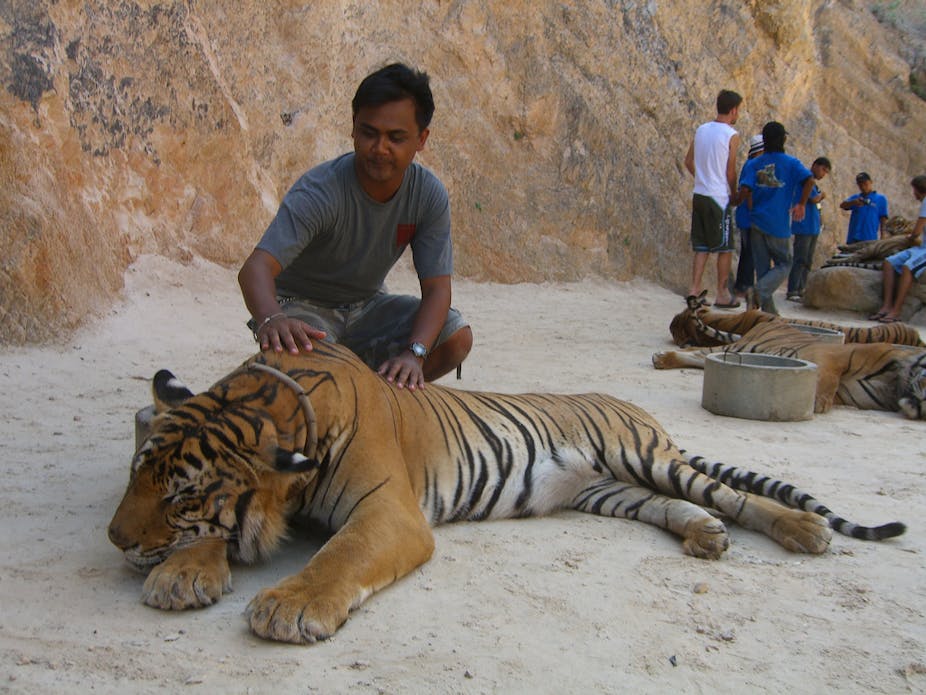You might have noticed recently that a plague of “selfies” with tigers appears to have overtaken mobile dating app Tinder (where users “swipe right” to indicate interest; left to reject). Globally, so many male Tinder profiles include tigers that there are blogs dedicated to them.
But involving tigers in human courtship isn’t without consequences. A recent campaign from Care for the Wild International stresses that tiger selfies place humans and wildlife at risk.
When it comes to taking photos with wildlife, tigers are just the tip of the iceberg. Having a photo with an exotic or wild animal may seem harmless, but it can pose a threat to the animal, person and potentially a whole species.
Ethical problems

There are ethical concerns about having photos taken with tigers. Big cat cubs and primates continue to be used as props for photos with tourists, particularly in south-east Asia, where the animals may be drugged, chained up or have teeth and claws (for cats) removed to prevent injury to people.
Photos with tiger cubs can also be taken at travelling and roadside zoos and petting displays in malls in the United States. When big cats or primates are fully grown, they are often unmanageable, and may end up locked up in basements, cages or in private zoos.
All tiger subspecies are endangered, with fewer than 3200 adults left in the wild (although estimates vary). Today there are more tigers in captivity than in the wild.
Fuelling trade
If users of dating apps set a popular trend of profile photos with tigers or other rare and exotic species, demand for similar photos may result in unscrupulous businesses breeding animals indiscriminately or poaching them from the wild.
Capture of endangered slow lorises for use as photo props and pets has increased as a result of videos posted on YouTube, with illegal trade increasing the species risk of extinction. After removing their teeth to avoid injury to people, these animals can never be returned to the wild.
Studies have shown that people who see images of chimpanzees in popular media are more likely to think that chimpanzees aren’t threatened, and that they make good pets. In fact chimpanzees are endangered; and adults are large and stronger than humans, and make terrible pets.
Animals in the wild
For years, wildlife tourists have been encouraged to “take only photographs, leave only footprints” but photos of tourists interacting with wildlife may fuel unrealistic expectations of “close encounters”.
International tourists seek intensely close interactions with large wild animals: swimming with orcas in Norway; cage diving with great white sharks in Australia; or trekking large mammals on land. In the excitement of the moment, tourists may put themselves and animals at risk of injury and disease.
International tourist revenues have formed the backbone of national economies, have built schools and clinics, and have saved natural habitat. However, close encounters with wildlife are associated with a number of problems and threats to health of wildlife, humans and the environment. The UK registered charity “Care for the Wild International” highlights the potential negative impacts that interactions between tourists and wildlife may have on people, wildlife and natural habitats.
Best-practice guidelines stipulate minimum “buffer” distances between people and wildlife, such as tourists keeping a distance of seven metres from mountain gorillas in Rwanda or Uganda to keep them free from human diseases and stress.
For some species, such as tigers in India, a fleeting glimpse from a distance may be all that a tourist is likely to get, which may lead to disappointment and damage to future tourism through poor visitor satisfaction. Photos suggest otherwise: a close up, one on one experience. In reality, there may be hundreds of other tourists leading to a less “intimate” experience.
Selfies to death
Apart from the potential suffering and abuse for animals used as photo props, close encounters can be a threat to people.
Tigers can be dangerous and kill or maim humans in natural habitats and in captivity every year.
Once tourist sites and humans become associated with food, wild animals may lurk around bins, camp sites and tourist spots. Whether in Gibraltar, India, Malaysia or Japan, overly aggressive monkeys beg and snatch for food that makes them fat and unhealthy (monkeys fed by tourists on Gibraltar in the past were called “bags of fat”).
The quest for the perfect photo opportunity or memorable close encounter, without understanding the animals’ behavioural repertoire or signs of aggression and stress, increases potential risk of injury to tourists, particularly if the wild animals are overly habituated, losing all fear of humans.
Close encounters also risk transmitting disease from animals to people, including diseases from monkeys in south east Asia and recently from camels in the Midde East.
Many emerging infectious diseases, known as “zoonoses”, have come from animals, including HIV, “bird flu”, and SARS.
The way we portray animals in wildlife selfies gives rise to all sorts of misperceptions that might inadvertently be pushing the animals that we consider special towards extinction.
Therefore, when you see a potential date cuddling a tiger, I urge you to swipe left.

